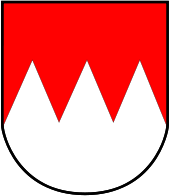Am Wochenende waren wir im Chalet und sind zu den sogenannten 'Cliffs' gewandert. Hatte ich schon mal beschrieben - da bin ich schon zichmal hingewandert. Allerdings gibt es keinen "Trail" sondern man muss sich irgendwie an der Himmelsrichtung oder sonstwie orientieren. Im Grunde genommen geht es immer nach Westen und zurück muss man halt nach Osten laufen. Irgendwann kommt man dann wieder zurück in die Zivilisation, d.h. man trifft auf einen Weg.
Wir wollten eigentlich den Sonnenuntergang im heiligen Tal der Algonquin betrachten. Ich dachte wir könnten dann noch so mit etwas Tageslicht wieder zurück laufen. Ich hatte dafür etwa eine Stunde eingeplant.
Wir sind dann doch etwas früher aufgebrochen - Gott sei Dank. Ich hatte nämlich die Dauer der Wanderung etwas unterschätzt und plötzlich war es stockdunkel. Aber auch so richtig! Es gab keinerlei Restlicht mehr, kein Mond oder sonstwas zu sehen - es war einfach nur noch Dunkel. Eine rabenschwarze Nacht.
Und wir befanden uns mitten in der Wildnis im Wald. Da geht es über Stock und Stein, es gibt sumpfartige Passagen und jede Menge Felsspalten und kleinere einfache Klettersteig Abschnitte. Das ganze ohne Licht. Alter, mir ist irgendwann die Düse gegangen weil ich nicht mehr wirklich wußte wo wir uns eigentlich befinden oder ob wir nicht z.B. im Kreis gelaufen sind und somit noch tiefer im Wald sind.
Ich dachte schon an das "worst case scenario", d.h. wir machen ein Feuer und bleiben die Nacht in der Wildnis (ohne jedes Equipment). Wir hatten noch etwas Wasser und gegessen hatten wir vorher und bei Tageslicht würde ich definitiv wieder zurück finden. So weit konnten wir eigentlich nicht von der normalen Passage "abgedriftet" sein. Aber es war einfach sau gefährlich und bei totaler Dunkelheit dauern 100 Meter unter den Gegebenheiten ca. 30 Minuten. Fuck.
Im Westen glaubte ich noch ein wenig minimale Helligkeit erkennen zu können und ich hatte immerhin einen Kompass dabei. Also: einfach grob weiter Richtung Osten vortasten. Insofern möglich.
Wow!!! Nach einer weiteren halben Stunde bin ich dann tatsächlich auf einen Platz gestossen welchen ich erkannte und ich wußte: dahinter kommt tatsächlich der Weg. Uff. Gerettet!
Gott sei Dank. Wir hätten schon überlebt, so dramatisch wäre das auch nicht gewesen aber eine Nacht im nassen Wald, bei 5 Grad Celsius ohne jedes Equipment oder Nahrung wäre sicherlich relativ unangenehm gewesen. Von dem ganzen "Viechzeuchs" was da so rumläuft mal ganz zu schweigen. Da sitze ich schon lieber am warmen Ofen mit einem Glas Rotwein zum Abendessen.
Man lernt halt immer noch dazu.


















